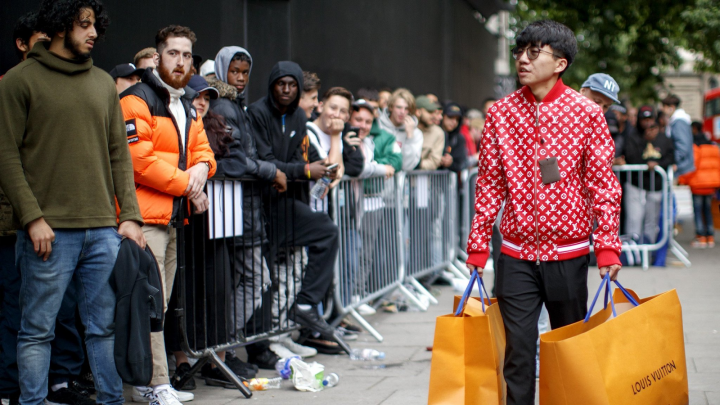
International vs. domestic streetwear brands: What’s worth the hype?
(Photo source: The Financial Times)
By Tiantian Shi
NANJING, China 一 Ask any hypebeast to name their favorite streetwear brands and they might rattle off a list that includes Supreme, Off-White, BAPE, Adidas and Yeezy. What they probably could not tell you is that the exorbitant price tags associated with these brands’ most sought-after items (such as a 45L suitcase originally retailed by Supreme in collaboration with Rimowa at $1,600 which is currently re-selling on eBay for $6,750) comes from the Veblen effect which can be observed in the increase in demand for a good with an increase in its price. This anomalous behavior is the result of a sociological phenomenon known as conspicuous consumption, referring to purchasing luxury goods to flaunt one’s wealth and social status.
While this phenomenon is common around the world, it is especially prevalent in China, where a significant portion of the population acquired great wealth in a short period of time. A visual survey of people on the streets of any Chinese city will offer an eye-watering array of Louis Vuitton handbags, Burberry scarves and Hermes belts. Chinese millennials prefer to mix their classic luxury labels with streetwear pieces 一 they pair Louis Vuitton with their Balenciaga, Burberry with their Undefeated, and Hermes with their Fear of God.
Part of the draw of designer streetwear labels in China is their limited availability. Many of these brands offer a small number of different items through time-sensitive raffles or weekly “drops” that usually sell out within seconds. Those not lucky enough to cop such items at retail prices are forced to look in the secondary market, where prices can more than quadruple depending on the hype surrounding an item.
This process is especially difficult for Chinese millennials who often lack access to the releases, which are restricted by region. To get around this, many will purchase bots 一 computer software programs that speed up the purchasing process by automatically filling out address and credit card information and thus moving the customer up in the checkout line 一 or will physically make a trip to Japan, the one country where Asia releases are usually made available. Here is where conspicuous consumption comes back into play. Streetwear brands require people to either have the know-how and luck to purchase at retail prices or to have the money to buy at resale. By getting their hands on these items, Chinese millennials can show that they’re on top of the latest streetwear trends and can afford to participate in them.
Domestic fashion retailers have taken note of this growing interest in streetwear fashion. A number of Chinese brands, such as Scissorism, Material Girl and AKOP have risen to meet consumer demand. The most notable development in this retail space, however, is that of Yoho!, a fashion-magazine-turned-e-commerce-store-turned streetwear empire that serves as one of the main authorities on streetwear trends in China.
To investigate this trend further, I visited Yoho!’s flagship store in Nanjing, just a few subway stops away from the HNC. The store not only offers a dizzying array of domestic and international streetwear labels, but also houses a small coffee shop and hosts regular pop-up stores to highlight different brands. The neutral-faced sales associates, dressed in dark-colored, oversized hoodies are stationed inconspicuously throughout the store and could easily be mistaken for customers. The tablets and phones in their hands nod to the fact that Yoho! is still primarily an e-commerce platform. Most items in the store have a QR code instead of a price tag and require customers to use the Yoho! app. While the online store carries over 1,000 different streetwear brands, the flagship store houses a select number of domestic brands on the first floor and more well-known and expensive international brands on the second floor.
Exterior of Nanjing’s Yoho! Store (Photo source: SEVENTIE TWO)
According to one Yoho! sales associate in Nanjing, “Streetwear is still a trend that is relatively new in China, so many millennials prefer to spend money on brands already recognized as trendy. They are beginning to explore some homegrown labels, but they aren’t willing to pay as much for them as they are for brands like Supreme and BAPE.”
While some high-end domestic brands like Sankuanz do well overseas where the streetwear scene is more mature, it hasn’t quite taken off in China. What is the point of paying $100 for a t-shirt if nobody knows how much you paid for it?
Chinese millennials might be trying to set themselves apart from older generations, but they are still trying to fit into the mainstream trends of their own generation.
Tiantian Shi is a HNC Certificate ’19/SAIS MA ’20 student hoping to concentrate in International Development or International Political Economy.

